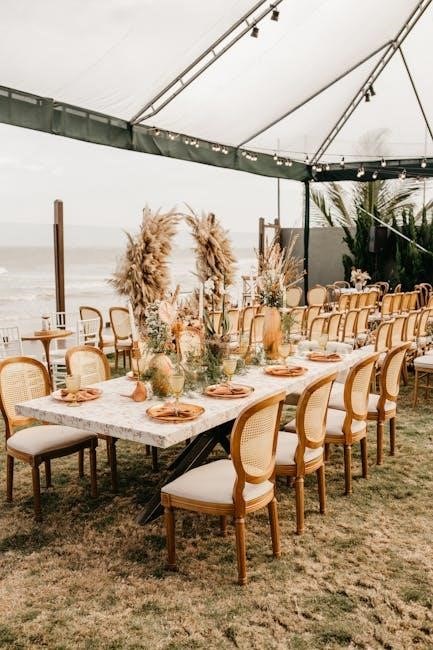Setting up a party tent is essential for outdoor events, ensuring shelter and style. This guide covers frame tents, pole tents, and pop-up canopies, focusing on proper installation, safety, and troubleshooting.
1.1 Importance of Proper Tent Installation
Proper tent installation is crucial for ensuring safety, stability, and structural integrity. A well-installed tent prevents risks like collapse, damage from wind or rain, and potential injuries.
Incorrect setup can lead to costly repairs, event disruptions, or even legal issues. Always follow manufacturer guidelines and conduct a final safety check before use.
1.2 Brief Overview of Party Tent Types
Party tents come in various styles, each offering unique benefits. Frame tents are sturdy, easy to assemble, and suitable for hard surfaces. Pole tents are traditional, often used for larger events, with a center pole design. Pop-up canopies are lightweight, portable, and ideal for small gatherings. Inflatable tents offer a modern look, while clear-span tents provide open interiors. Each type caters to different event needs, ensuring versatility and functionality. Choosing the right tent type enhances event success and attendee comfort.
- Frame tents: durable and versatile.
- Pole tents: classic and spacious.
- Pop-up canopies: quick and portable.
- Inflatable and clear-span tents: modern and open designs.


Choosing the Right Party Tent
Selecting the perfect tent involves considering size, type, and event needs. Ensure it accommodates guests comfortably and aligns with the event’s theme and location requirements.
2.1 Selecting the Appropriate Size for Your Event
Choosing the right tent size ensures comfort and functionality. Measure the event space and consider guest count, seating style, and additional features like dance floors or buffet areas. A 10×20 tent suits small gatherings, while larger events may require a 20×30 or bigger. Always check tent capacity ratings to avoid overcrowding. Proper sizing prevents safety hazards and ensures a pleasant atmosphere for all attendees. Use size charts or consult experts to make an informed decision.
2.2 Understanding Frame Tents vs. Pole Tents

Frame tents and pole tents differ in design and setup. Frame tents use metal or plastic frames for sturdy, freestanding structures, ideal for various surfaces like grass or concrete. They are easier to assemble and offer a sleek appearance. Pole tents rely on center poles and ropes for support, often requiring stakes and more space. Frame tents are generally more durable and versatile, while pole tents are simpler and cost-effective. Choosing the right type depends on event needs, terrain, and desired aesthetics. Ensure the tent is waterproof and follow manufacturer guidelines for assembly.
Pre-Setup Preparation
Preparation is key for a smooth tent setup. Ensure the site is level, clear of debris, and marked for utility lines. Gather all tools and equipment beforehand to avoid delays.
3.1 Checking the Site for Safety and Levelness
Before setting up your party tent, inspect the site for safety and levelness. Ensure the ground is firm, clear of debris, and free from overhead obstacles. Check for underground utilities by calling Diggers Hotline (8-1-1) to avoid accidents. A level surface is crucial for stable tent installation. If the ground is uneven, use shims or adjust the tent legs accordingly. Safety should always be your top priority to prevent structural issues and ensure a secure setup for your event.
3.2 Gathering Essential Tools and Equipment
Gathering the right tools and equipment is crucial for a smooth party tent setup. Essential items include sturdy stakes, durable ropes, a heavy-duty hammer, wrenches, and a measuring tape. A ladder or step stool is necessary for reaching high areas. Don’t forget a repair kit for unexpected tears or punctures. If setting up on hard ground, water barrels or weights are recommended for stability. Ensure all tools are easily accessible to save time and effort during the assembly process. Proper equipment ensures a safe and efficient installation of your party tent.
Step-by-Step Setup Process
Learn how to assemble frame and pole tents securely. Follow detailed guides for unpacking, framing, attaching canopies, and ensuring stability. Master the process for a successful event setup.
4.1 Unpacking and Organizing Tent Components
Begin by carefully unpacking all tent parts, including poles, frames, stakes, and canopy. Organize components to ensure easy access during assembly. Lay out instructions for reference. Check for any missing or damaged items and verify all parts against the provided checklist. Separate poles, connectors, and fabric to avoid confusion. This step ensures a smooth and efficient setup process, preventing delays and potential mistakes during assembly. Proper organization is key to a stress-free tent installation experience.
4.2 Assembling the Frame or Pole Structure
Start by constructing the tent’s skeleton. For frame tents, connect the metal poles to form the base and roof structure, securing them with pins and clips. For pole tents, place the center pole upright and attach side poles to create the canopy’s peak. Ensure all connections are tight and aligned properly. Stand the frame upright and stabilize it with temporary supports. Double-check the structure’s balance and symmetry. This foundational step ensures the tent’s stability and prepares it for canopy attachment. Proper assembly is crucial for safety and durability during the event.
4.3 Attaching the Canopy and Sidewalls
Once the frame or pole structure is secure, attach the canopy by aligning its grommets with the frame’s pins. Tighten the straps or ropes to ensure a snug fit. For sidewalls, start by clipping them to the canopy’s edges, then secure them to the frame using Velcro or zippers. Ensure all seams are aligned and tight to prevent sagging. If using windows or doors, make sure they are properly fastened. Finally, adjust the sidewalls to create a seamless enclosure. This step ensures the tent is weatherproof and visually appealing, ready for final checks and use.

Securing and Stabilizing the Tent
Stakes, ropes, and anchors are essential for securing the tent. Tighten all straps and ropes to ensure stability. Use weights for added reinforcement, especially in windy conditions.

5.1 Using Stakes, Ropes, and Anchors
Securing your tent with stakes, ropes, and anchors is crucial for stability. Drive stakes into the ground at a 45-degree angle to ensure a firm hold. Tighten ropes evenly around the tent frame, avoiding slack. Use heavy-duty anchors like sandbags or weights for added security, especially on hard surfaces. Ensure all ropes are tied tightly to prevent shifting in the wind. Regularly inspect stakes and ropes for signs of wear or loosening. Properly securing your tent ensures safety and prevents damage during events.

5.2 Adding Weights for Extra Stability
For added stability, especially on hard surfaces like concrete or asphalt, use weights such as sandbags or water-filled barrels. Place them evenly around the tent’s perimeter, securing ropes tightly to prevent shifting. Ensure weights are heavy enough to withstand wind and weather conditions. Avoid using loose objects that may move or cause damage. Regularly inspect the setup to ensure all connections remain tight and weights are properly positioned. This step is vital for maintaining tent stability and ensuring a safe and successful event.

Finalizing the Setup
After assembling, tighten all connections and ensure the canopy is securely attached. Verify waterproofing by inspecting seams and applying sealants if needed. Conduct a final inspection.
6.1 Tightening All Connections
Tightening all connections ensures stability and safety. Begin with the roof frame, ensuring bolts and screws are securely fastened. Check corner fittings and side poles for snugness. Use wrenches or Allen keys as specified. Tug gently on each section to confirm firmness. Pay extra attention to the canopy attachments, making sure they’re tightly secured to prevent flapping in the wind. Finally, inspect all ropes and straps, tightening any loose ends. Proper tightening prevents structural issues during the event, ensuring a secure and durable setup for your gathering.
6.2 Ensuring the Tent is Waterproof
Ensuring the tent is waterproof is crucial for protecting your event from rain. Start by inspecting the canopy and sidewalls for any tears or gaps. Apply waterproofing sprays or sealants to seams and stitched areas. Secure all Velcro and zip connections tightly to prevent water seepage. Check that the canopy is evenly spread and tightly attached to the frame to avoid sagging, which can collect water. For added protection, ensure the tent is pitched on a slight incline to allow water to run off. Regularly clean the roof to remove debris that might compromise waterproofing during rainfall.

Common Challenges and Troubleshooting
Common issues include leaks, wind damage, and unstable structures. Regular inspections, tightening connections, and using weights can prevent these problems, ensuring a safe and secure setup.
7.1 Addressing Leaks or Tears
Leaks or tears in your party tent can be addressed with a repair kit. Inspect the tent for damage and apply patches or adhesive to affected areas. For seams, use waterproof sealant to prevent leaks. If tears are large, reinforce them with durable fabric patches. Regularly check the tent’s condition before events to avoid last-minute issues. Testing the repairs by spraying water ensures the fixes are effective. Proper maintenance extends the tent’s lifespan and guarantees reliability during events.
7.2 Managing Wind or Rain Damage
Wind and rain can severely damage your party tent if not properly managed. Ensure the tent is securely anchored with stakes, ropes, and weights to withstand strong gusts. Regularly inspect the tent for loose parts and tighten connections. In heavy rain, check for pooling water on the canopy and eliminate it to prevent sagging. Position the tent away from trees and power lines to avoid branch damage. For added stability, use sandbags or heavy weights on the tent’s legs. Always follow manufacturer guidelines for wind and rain resistance to ensure safety and durability.
Post-Event Dismantling
After the event, carefully disassemble the tent, ensuring all parts are removed safely. Clean and store components properly to maintain durability and readiness for future use.
8.1 Safely Disassembling the Tent

Begin by removing decorations and sidewalls. Detach the canopy from the frame, folding it neatly to prevent damage. Carefully take apart the poles and frame sections, ensuring all connectors are secure. Use a soft cloth to wipe down surfaces, removing dirt and moisture. Store each component in labeled bags or boxes to maintain organization. Avoid forcing parts apart, as this can cause damage. Work methodically to ensure no pieces are left behind or misplaced. This process ensures the tent remains in good condition for future events.
8.2 Cleaning and Storing the Tent Properly
After disassembly, clean the tent thoroughly. Use mild soap and water to remove dirt and stains, avoiding harsh chemicals that may damage the fabric. Allow all parts to air dry completely to prevent mildew. Store the tent in a cool, dry place, away from direct sunlight. Use durable storage bags or containers to protect against pests and moisture. Keep the instruction manual and repair kit with the tent for easy access. Proper storage ensures the tent remains in excellent condition and ready for future use.